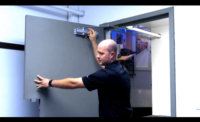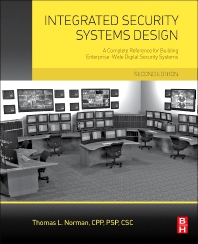Harsh installations demand you pick the right product, but that is just the tip of the iceberg in a successful design. Manufacturers develop products with a wide variety of environments in mind, and in many cases those will do just fine. But knowing when they won’t and how to make sure the access control system will last and operate safely and correctly is up to the integrator.
“Beyond just picking the correct product we are close to the 80 percent mark on responsibility,” says integrator Ron Kaczar, general manager, Colorado operations, VTI Security, Burnsville, Minn. “Even though it may be hardened, there are still things to consider when it comes to getting the cable to the actual device, and having something appropriate to mount it to.”
From deciding what is a harsh or hazardous environment, to choosing the correct products and peripheral devices, to ensuring the safety of employees and installers, there is a lot to think about on the integrator side. SDM recently spoke with both integrators and manufacturers, who shared nine crucial tips from start to finish of the job.
1. Determine if THE ENVIRONMENT is harsh or hazardous.
“Harsh is a pretty broad term,” says Christopher Sincock, vice president, security business, DAQ Electronics LLC, Piscataway, N.J. “I would define it as anything other than you would feel comfortable working in wearing normal clothing. Or the temperature may be fine but the equipment is exposed to airborne hydrocarbons, greases, oils or chemicals, or even explosive elements.”
Sometimes harsh is less than obvious. Dirt, static, even vibration can be a harsh environment depending on the application.
With the exception of intrinsically safe explosion proof situations (which require specific and highly regulated enclosures and equipment), harsh and hazardous are really two sides of the same coin, says Dave Adams, senior director of product marketing, HID Global, Austin, Texas. “There is a bit of difference between harsh and hazardous, but you are going to find the same techniques used in a lot of the products.”
2. Understand how it is harsh.
“There are two types of environmental concerns: those affecting the product and those affecting the user,” says Frank Gasztonyi, chief technology officer, Mercury Security, Long Beach, Calif. “There could be harsh lighting conditions and if that is not considered they wouldn’t be able to use the device effectively. The integrator has to look at things from the user’s standpoint as well as the equipment’s.”
This is particularly true in hazardous situations, adds Christopher Wetzel, executive vice president and founder, Intertech Security, Pittsburgh. “We have a lot of applications that deal with drug manufacturers where if you ingest or get the product on you it could kill you. It is not so harsh in how it affects the readers, but it is potentially harsh on the employees if they don’t use the equipment properly. Another example is the petroleum and gas industry where if they make a mistake they could create an explosion.”
3. Pick harsh-environment-friendly technology when possible.
“Everyone’s life is a little easier with newer electronics,” Sincock says. “They tend to be manufactured with epoxy coating all over and are pretty well protected from the environment whether inside or outside.”
However, there are limits. The standard temperature range for proximity and contactless smart card readers is around -40 deg. F to 150 deg. F, which covers most applications. In addition most are potted, protecting the electronics from a host of harsh elements.
Chris Wiker, designer and manager at integrator AT-NET Services, Charlotte, N.C., generally prefers the proximity or contactless technology for harsh environments. “If there is a caustic environment or heavy use, the fewer moving parts, the better off you are,” he says. “Plus they are typically a little more hardened and sealed on the backside. There is nothing exposed except the wire.”
In an environment that exceeds those limits or has other environmental conditions, however, those readers need to be either specially made or put in an appropriate enclosure.
Do Biometrics and Harsh Environments Go Together?On the one hand, many integrators tend to shy away from biometrics in harsh environments because of biometrics’ reputation for sensitivity to changes (such as dirt on fingers) or less than impervious nature (inability to get wet or very dirty). However, some biometrics manufacturers have taken the challenge of harsh environments head on and have some promising solutions. “We do quite a bit of industrial applications with hand geometry,” says Jonathan Mooney, Allegion. “We have a good, robust design that is not reliant on placing the hand on the lens for a bottom-up picture.” Newer biometric technologies are helping push them into more and more environments, says Dave Adams, senior director of product marketing, HID Global. “Over the past five years biometric sensors have made leaps forward in their ability to work in harsh environments. With new multi-spectral technology they can penetrate past that initial layer of skin and read the finger and vein below the skin, allowing them to still get a good read in harsh situations.” Gary Jones, business unit director of biometric access and time solutions, MorphoTrak, Alexandria, Va., says the company’s system was specifically designed with harsh environments in mind. “We started in South Africa in the mines at a time when there was a massive spike in interest in biometric-only solutions. If you think about the construction or mining industries, they are very dusty, dirty environments. Contaminates will build up on the scanner surface as well as on the fingers and introduce false information or data to the biometrics.” MorphoTrak developed technology that relies on both hardware and software perspectives to deal with that false data. “You need to have a large area scanner in harsh industries,” Jones says. “The larger the capture surface, the more flexibility there is if a person damages a finger or there is a lot of dirt. There is a lot more ridge flow to work with which helps feed into strong algorithms to make matching more reliable.” |
4. Pay attention to wiring and peripheral devices.
“Probably the biggest pitfall is not picking up the right hardware or wiring,” says Jim Pope, president, Barcode Automation Inc., Winter Springs, Fla. “There is pressure on the integrator to reduce cost on installation and wiring can be a tempting place to do it.”
Don’t, Adams says. “It comes right down to the wire you use, literally. I have had personal experience with wire at -20 deg. F and seeing the insulation crack and shatter while pulling the wire.”
Also be careful to seal where the wiring goes in to the reader and install it from below the reader, not above, to prevent water getting in.
“Some products may need shielding and gaskets to provide moisture protection, while others may not be rated to operate at extreme temperatures,” cautions Bryan Sanderford, national sales manager, Dortronics Systems Inc., Sag Harbor, N.Y. “A power supply located on the roof to control skylight ventilators will need weather sealed enclosures and special cooling for summer heat, for example.”
The conduit should be water tight as well, says Dennis Geiszler, vice president of marketing, Keri Systems, San Jose, Calif. “Integrators need to ensure cabling is done properly and conduit is sealed. Also make sure other components such as locks can handle the environment.”
For example, magnetic locks tend to be more durable in certain areas, says Adam Auer, product manager for Securitron, ASSA ABLOY EMS & OEM Group, Phoenix. “There is not an environment where I wouldn’t use a mag lock except maybe in explosion proof because of the metal on metal. But some of the more sensitive electronic locks may not be as conducive to harsh environments. They are not ready for water intrusion.”
5. Check data sheets.
Many products don’t come labeled for “harsh” environments. That means the integrator has to dig a little for the details.
Jason Ouellette, product line director for access control, Tyco Security Products, Westford, Mass., agrees. “Probably the best advice I could give is to make sure integrators have really done their due diligence on understanding the specifications of the product.”
Integrator Jeffrey Jones, security systems engineer, Prime Communications Inc., Elkhorn, Neb., says a little digging can definitely pay off. “Take your time to engineer the quality at the beginning and make sure you have all the right parts and pieces. Verify parts and equipment. One of the things I take into consideration is operational temperature ratings and what voltage all of the items need to run on.”
6. Know the codes and ratings.
UL, ANSI, OSHA, BMHA, NFPA, IP — Manufacturer design specs are just the beginning. From there other standards come into play.
For example, a National Electrical Manufacturers Association (NEMA) type 4 enclosure is designed to withstand a pressurized spray with a hose as well as dust and dirt, where a higher rating might mean it can be a harder spray or even complete immersion in water. NEMA rated enclosures are important to understand, particularly for equipment that isn’t inherently designed for harsh or hazardous environments. Most access control manufacturers don’t include enclosures, but are more than happy to work with the integrator on recommending the correct rating and level of protection for their equipment.
Another common rating on security equipment these days is IP65 or higher. The first number represents dust-proof and the second is moisture protection, explains Cheri Wolfe, OEM sales manager, Essex Electronics, Carpinteria, Calif.
“All of our RFID readers are IP65 rated, which protects from dust and low volume water jet,” says Jonathan Mooney, business leader, Allegion, Carmel, Ind.
“We are known for rugged keypads, card readers and exit switches,” Wolfe says. “Our electronics are encapsulated in epoxy and our readers and keypads are rated IP66.”
Gasztonyi recommends installers obtain copies of relevant specifications such as UL294 (for salt, spray and corrosive) and invest the time to have someone in their organization know those specs. “Typically a manufacturer will attach a simple line ‘rated for outdoor use.’ But there are various tests and if they understand those they can go back and ask the appropriate questions of the manufacturer.”
7. Ask the right questions.
“Ask the customer if there is any special circumstance,” Ouellette advises. “We had a customer in Florida that bottled orange juice. It was indoors but at the end of every shift the reader was getting washed down and it failed within three weeks of installation. Just because it is interior doesn’t mean it won’t be subjected to harsh conditions.”
Wetzel agrees. “We need to learn what type of business it is, and what they have in the way of materials that may be corrosive or cause explosions. Often I find we have layers. It might be a typical office, but inside that room there is corrosive material.”
8. Ask the right people.
Knowing who to ask is just as important as knowing what to ask, Wiker says. “A lot of times we meet with IT directors, but we also like to meet with facility managers and pick their brains and learn from their mishaps. We ask them what problems they have run into with low voltage communications systems in the area, chemical reactions they have seen to certain metals, salt corrosion and what they have done to help alleviate those problems.”
Integrator Bill Daniel, senior national account manager, Stanley Security Solutions, Burnaby, British Columbia, Canada, agrees. “If at all possible visit the site and speak to the people there. A lot of harsh environment work is about the logistics of installation,” he says.
Ask specifics about the environment, Kaczar advises. “Some sites may tell you it is safe to breathe without respiration, but you have to learn it may still be corrosive due to saline levels.”
Asking the manufacturer can be another important step, he adds. “The product may meet the minimum requirements but if you explain exactly what it needs to do, they may suggest leveraging more technology to make the site safer.”
9. Install it properly.
“You cannot treat installing a device in a harsh environment the same as inside a conference room,” Sincock says. “You need to think like you are in a HAZMAT suit. That is the electronics inside that suit.”
Take your time and don’t rush the job, Geiszler suggests. “Make sure every termination is perfect. Where you are splicing wires or connecting terminal blocks, make sure those are good and that anything exposed to the outside is installed to withstand weather, moisture, corrosion, heat or dust.”
Follow grounding rules, Ouellette adds. “Also follow proper sealing. There are so many different types of materials that readers can be mounted to, including brick, cement, wood, steel or glass. Each has unique requirements.”
Develop a careful plan to install the equipment, Daniel says. “Years ago we did a job where all the equipment was constructed and put together in a warehouse for a harsh environment in northern Canada. Everything was perfect and running. We put it in a container and shipped it to the site, where it sat for two days on the platform. The electronics and all the equipment froze and the integrity was either gone or in question. The logistics of getting it to the site can be as important as the installation itself.”
Lastly, check your work. “I can build my product to be the top safety standards Class 1, Division 2 by OSHA,” Adams says. “It is able to be placed in an environment with gasses present all the time under abnormal conditions. But if someone forgets to put that seal in the conduit that leads from my device out of the area, you have the potential for disaster. It is critical to not only pick the right device but to install it from end-to-end to code.”








